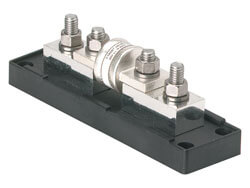What is the wire temperature rating of the wire? That is important for knowing its current rating
To do it right, there are two options (probably more, but 2 that I am aware of) for main circuit protection with lithium batteries:
- A properly rated Class T fuse and a manual disconnect switch
- A properly rated high AIC DC circuit breaker (no need for the disconnect switch)
By properly rated, I am referring to
A. The fuse is DC rated for the voltage of your circuit
B. the proper current rating for your circuit
C. a high AIC rating (20kA+ seems to be the best practice)
Neither option is cheap (expect $50-100), because they must be rated for the much higher currents that lithium batteries can produce in a dead short situation. Circuit breakers that meet these conditions can be hard to find in a convenient form factor.
The fuse
@Cdkipp posted above meets all these conditions, not sure if that is the right size (current rating) or not without knowing your max expected load and your wire type, but its available in multiple sizes.




